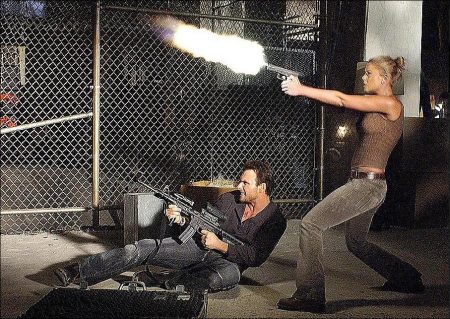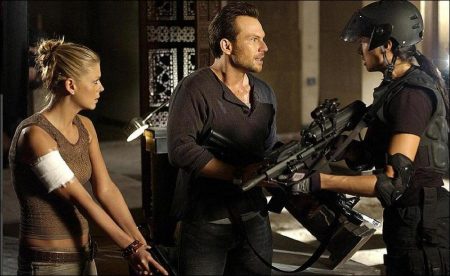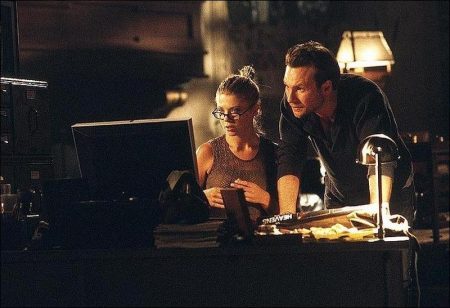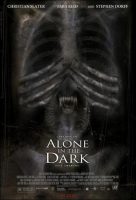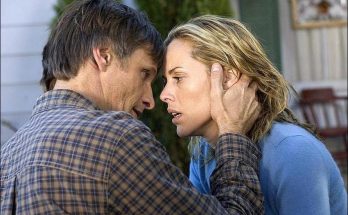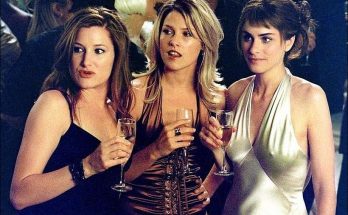Tagline: Evil awakens.
Edward Carnby, detective of the paranormal, unexplained and supernatural, investigates a mystery that brings him face to face with bizarre horrors that prove both psychologically disturbing and lethal, as he discovers that evil demons worshiped by an ancient culture called the Abskani are planning on coming back to life in the 21st century to once again take over the world… and only he and a young genius with an incredible memory (and his ex-girlfriend), Aline Cedrac, stand in their way.
Standing in Carnby’s way, however, is the impact that a brief encounter with an evil spirit called the Queen had upon his mind, as he slowly finds himself overpowered by the forces of darkness as they eat away at his very sanity. You wake up in the middle of the night with the feeling someone is in the room with you. You get a flash of panic as you fumble for your bedside lamp. But when you turn on the light, no one is there.
You might feel safe…but just because you can’t see something doesn’t mean it’s not there. Watching. Waiting. Existing at the fragile boundaries of our perception. There is a world around us, a world most of us never see — or never want to see. As a child, Edward Carnby was given irrefutable proof of that world. He hasn’t slept well since. Now, twenty years later, Edward is a paranormal investigator. When the irrational become undeniable, he is there. He is not out to change your mind. But he may be the only one who can save your life.
Now, the greatest mystery of Edward’s past is about to become the most dangerous case he has ever faced. Nineteen people have disappeared, and they have only one thing in common — each one grew up in the same orphanage as Edward. Looking for answers, Edward learns that an ancient artifact of considerable power has been discovered in a long-lost shipwreck. Amidst mounting danger, he turns to Aline Cedrac, a brilliant anthropologist who’s also his ex-flame — and the only person he really trusts.
In a world of ancient evils, lost civilizations, shadowy government conspiracies, and deadly paranormal threats, Edward and Aline come together to confront a supernatural enemy unlike anything they’ve ever seen before…one whose very existence could threaten all of humankind.
About the Production
Having brought the best-selling Sega videogame House of the Dead to the big screen, director Uwe Boll was approached by the creator of Alone in the Dark, Part IV to transform the popular Atari videogame into a theatrical experience. The German-born Boll, whose oeuvre includes such homegrown horror fare as Run Amok (1992), the American horror yarn Sanctimony (2000) and the thriller Blackwoods (2002), appreciated the three-dimensional characters of the videogame and the complex plot of the film.
“All the kids that Edward grew up with – why have they disappeared but he hasn’t? Suddenly his work as a paranormal investigator turns personal and he’s committed to finding these kids,” explains Boll. The character’s initial focus, he says, leads to a much more elaborate plot involving a shadowy government organization, ancient civilizations and evil creatures that have been hiding for thousands of years. “It’s a big movie, but it all comes together very well.”
Working with producer Shawn Williamson, with whom he worked on Blackwoods, Boll set about creating a piece of entertainment that could stand on its own for general audiences while still satisfying the game’s loyal fans.
“Keeping a movie true to a videogame is tough, in part because they’re very different mediums,” admits Williamson. “A game is interactive and players can take it in different directions. A film is the same experience every time you watch it. Yet I think we succeeded in capturing the energy and spirit of the game while bringing a lot of the back story of these characters to life.”
Elan Mastai, one of three screenwriters on the project alongside Michael Roesch and Peter Scheerer, appreciated the task of adapting a video game, inspired by the classic horror writing of H.P. Lovecraft, into a feature film. “Games are great source material because they have really elaborate back stories,” says Mastai. “It often takes 50 hours to tell a game story, so there’s a real depth to that universe.”
While putting audiences in the point-of-view of a game player, Boll worked to bring “the creepiness and the suspense of being alone in the dark” to the screen. “We kept things really dark so that, as an audience member, you can’t clearly tell what’s around you and what’s going to happen next.”
That perspective is shared by the film’s special effects coordinator John Sleep, who was responsible for the special effects magic behind such films as Boll’s House of the Dead, Scary Movie 3 and Catwoman. “We’ve actually tried not to show too much on camera, to leave a lot in the shadows so that it leaves more to the imagination.” Sleep isn’t suggesting, however, that the film doesn’t have its share of pyrotechnics. “There are lots of explosions, lots of fireworks, and lots of people running around in dark places with flashlights in the fog. It’s been a lot of fun!”
One particularly exciting scene involved a mine shaft. “It’s a huge crane shot that leads to the final assault of the creatures on the soldiers, and we think it’s a very innovative shot,” says Williamson. Thanks to the film’s ambitious and resourceful production team, Williamson believes Alone in the Dark achieves “a large-budget feel despite its moderate, independent-sized film budget.”
Christian Slater, who claims he “always believed in the abnormal more than the paranormal,” appreciates the project’s combination of imaginative storytelling and compelling characters. “I got the videogame after I read the script and liked seeing that there were real characters in both of them, people you could identify with,” says Slater, whose recent films include Windtalkers, 3000 Miles to Graceland and The Contender.
The physical nature of Slater’s role also provided him with a unique opportunity to use his recently developed karate skills. Tara Reid, whose work in the American Pie movies and My Boss’ Daughter has turned her into a rising star, was eager to take on her first action role. “I get to shoot a gun and play a scientist,” says the actress. “There’s a lot of action in the film, but it also has a heart because of the romance between Edward and Aline.”
Immensely pleased with his cast, Boll calls Christian Slater “a great actor” who is now poised to become “a big action hero,” while he believes Reid’s work confirms her status as “a serious actor.” A fan of the action horror hit Blade, the director also praises Stephen Dorff as his “absolute favorite” for the role of Commander Burke.
Principal photography began July 14, 2003 in and around Vancouver. “We blocked part of the city’s downtown so that we could show it empty,” explains producer Williamson. The physical assets of Vancouver were complemented in post-production by thousands of visual effects shots, including close to 700 CGI sequences. A catacomb of tunnels and sand chambers was also created.
The end result, Boll hopes, will be an atypical horror movie, “a paranormal suspense story with elements of thriller and horror that will appeal to a very wide audience.” Mastai believes Alone in the Dark succeeds because of its fresh approach towards the paranormal. “The story assumes that there are these paranormal things around us all the time, lingering at the fringes of our perception,” he explains. “For the most part, we don’t bother them, and they don’t bother us. But every once in a while the two worlds collide…”
Alone in the Dark (2005)
Directed by: Uwe Boll
Starring: Christian Slater, Tara Reid, Stephen Dorff, Mark Acheson, Daniel Cudmore, Karin Konoval, Darren Shahlavi, Catherine Lough Haggquist, Craig Bruhnanski, Matthew Walker
Screenplay by: Elan Mastai, Michael Roesch, Peter Scheerer
Production Design by: Tink
Cinematography by: Mathias Neumann
Film Editing by: Richard Schwadel
Costume Design by: Maria Livingstone
Set Decoration by: David Birdsall
Art Direction by: Peter Stratford
Music by: Reinhard Besser, Oliver Lieb, Bernd Wendlandt, Peter Zweier
MPAA Rating: R for violence and language.
Distributed by: Lionsgate Films
Release Date: January 28, 2005
Visits: 87
